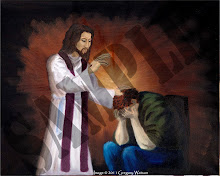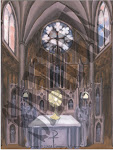Having finally made it to Haiti, we were now about to commence our rigourous trek up the mountain--and I was going to learn a lesson in humility.After two and a half motion-sick hours of insane traffic and death-defying mountain "roads", we arrived at the little settlement of L'Assyle, which was the end of the line for our "tup-tup". Once we had left Port-au-Prince, we stopped briefly at a gas station in Leogane, and picked up Père Ronal's cousin, and our translator for the trip, Michael (which he pronounced Mi-kay-el). Since the five of us were already crammed into the cab of Père Ronal's Hylux, Michael rode in the tail, seated on top of our luggage and holding onto the straps, literally for dear life. He did, however, inform us that his seat was the most comfortable of all of ours, which, after wanting to be ill for most of that journey, I had little trouble believing. This bit of information led us to each take a turn riding in the back on the way back to Port-au-Prince on our way home.
L'Assyle, as I mentioned, was as far as the pick-up could take us, and so we disembarked and prepared for the rest of the hike. All around us gathered curious and friendly Haitians, who unloaded our luggage from the truck and loaded it onto three mules. Then we began our slow, long, and hot ascent the rest of the way to Beau-Sejour.
When you see pictures of Haiti in the news, especially in the time since the earthquake, you end up having a difficult understanding of why this country is called "The Jewel of the Carribean." All one sees, primarily, is the decay and desperation of Port-au-Prince. Outside of that city, however, the beauty of Haiti really takes hold. The name of the country in Creole is "Ayiti", which means "mountainous"--and a more apt name could not be found. Every glance was breathtaking; every view was a vista. Though denuded of its trees, leaving the soil eroded, Haiti's mountains nevertheless had much vegitation, primarily banana trees and bamboo. How much more lush would this tropical paradise have been had previous generations been more environmentally-conscious? Nevertheless, I wore out my fellow-travellers with my continual exclamations of "I want to paint that!"
I already mentioned our three load-bearing companions, but there was a fourth mule who travelled with us. He wasn't for our luggage, but rather for us, if we came to have need of him. After my spell of exhaustion back home exercising with Nassrin (mentioned in the introduction to the last chapter), I was determined to not be the first person who needed the mule. I persevered up the hill on foot, trying to keep myself hydrated, but I could feel the tropical mid-morning beating down on me. I looked behind and realised that Nassrin herself, who had expressed doubts at my fitness to travel in Haiti, had been the first to succumb to the heat and mounted the mule. With smug self-satisfaction, I continued on for about another five minutes when I could feel the effects of the heat, and my pride, take its toll. I thus promptly asked (ordered, really) Nassrin to get off the mule so I could ride it. While she obliged, it was too little, too late. As I rode the mule, I began to feel nauseous. More, my hands began to seize up, and finally, my left leg went completely numb, causing my foot to come free of the stirrup! Père Ronal kept looking back at me and seeing me looking more and more ill, and asking, "Koumon-w ye?" Which is "How are you?" I kept replying, "Pa pi mal," meaning, "Not bad." But when I couldn't even pronounce the "l" in mal any longer, I knew it was getting bad, so I asked to stop in a grove of banana trees and lie down.
This simple request turned out to be more complicated than anticipated. First, when they asked me to dismount, I immediately began to climb off on the right side of the mule, since my right leg still had feeling, and my right foot was still in the stirrup. As soon as I made to go in that direction, a host of Haitians began yelling at me to stop and dismount on the left side (I never did find out why one should not dismount on the right side of a mule). Père Ronal started to guide me off the left side of the mule, and I slid sideways in order to get my left foot onto the ground, while still having my right leg slung over the mule's back! This is an uncomfortable position for a person in good health! Since I had no use of my seized-up hands, this ungraceful dismount caused me to spill my remaining water that I was barely holding on to. Once off the mule, I tried to lie down, to the protest of everyone present. But I didn't care--I had no choice! So I laid down in the red terracotta mud of which Haiti's mountains are composed, and all the concerned Haitians gathered 'round and looked down at me. I'll never forget one older man, concern for me etched in his wrinkled face, as two bright eyes peered at me from below a woollen toque! While I was suffering from heat exhaustion, this man had on Canadian winter-wear!
Nassrin had moved on ahead since my mounting of the mule, and one of the Haitians was quickly sent to bring her back. Meanwhile, blessed Michael began massaging my hands and working the muscles in my legs. When Nassrin rushed back, she nearly panicked at the sight of me on the ground, but kept her cool and instructed Père Ronal to make sure I too was kept cool. Water was brought out and they removed my shirt and soaked it. Then they tied it around my head. After about ten minutes, I had sufficiently recovered enough to resume our trek. One thoughtful Haitian man took his machete and cut bamboo staves for both me and Nassrin. I kept that staff for every hike during our remaining time in Haiti, and would have brought it home with me as a souvenir, but it was too long to pack away in order to get it on the plane. Nevertheless, it came in very handy throughout the week, keeping me from stumbling on the rough, muddy-clay mountainside.
Thankfully, this spell of heat exhaustion did indeed serve to make me stronger. It seems to have sped up the acclimatisation process to the warm tropical weather, because from that point on, the heat never really affected me in any extreme manner, though others on our team had their own difficulties later in the week. It seems a principle of life that suffering can be to our good. Perhaps "whatever doesn't kill me only makes me stronger" is a bit too glib to be a universal law, but there is truth to the adage, "no pain, no gain." The difference is in how we react to it--what we choose to do with the suffering. Had I continued to tough it out and ignore the symptoms, it could possibly have killed me. But being humbled and recognising my weakness and my need, I could accept the help required to recover.
What is true in the physical is equally so in the spiritual realm of life. Life often sucks. Just last night, my car was broken into, my GPS and several CDs were stolen, and I'm out a couple hundred dollars replacing the window. And that is just a small trifle compared with what so many people, like my friends in Haiti, go through every day! When we suffer alone, railing at the heavens in futility, then the devil steals our joy. Spiritually we begin to waste away, to die. But there is an alternative. We must choose to trust in God, to offer our suffering to Him. In so doing, He unites it to the suffering of His Son on the Cross. Our pain takes on a new, redemptive, healing dimension in the lives of others--maybe even others we'll never meet, and never know how our gift has influenced them; maybe our own friends and family. We can waste our suffering, or we can make it fruitful.
And in the end, we'll arrive at the top of that Mountain, just as I arrived with my team in Beau-Sejour.
Coming up, a taste of good ol' southern hospitality, as we meet the community with which St. Margaret Mary had twinned--our brothers and sisters in Christ.






